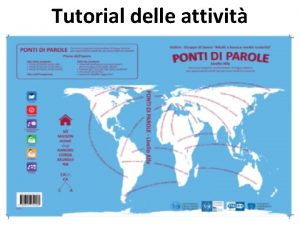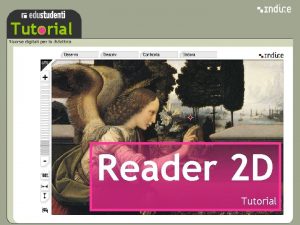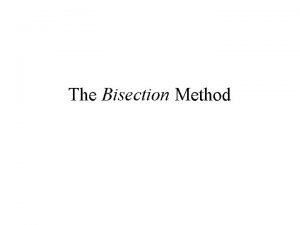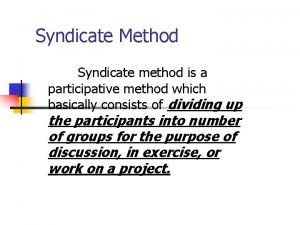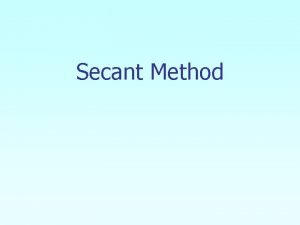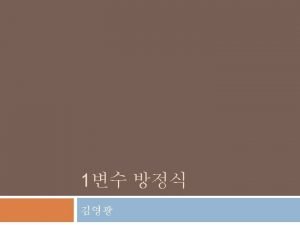Writing the Method Section In this tutorial you























- Slides: 23

Writing the Method Section In this tutorial, you will learn what to include in your paper’s Method section and how to organize that information. Click the “Next” button in the lower right corner to begin. Copyright Mark Mitchell & Janina Jolley 1996 -2012. Quit Next

Goals of the Method Section When you write the Method section, you should have two main goals: 1. To help casual readers understand what it would be like to be a participant in your study. 2. To give motivated readers enough information so that they could replicate (repeat) your study. To accomplish these goals, authors divide the Method section into parts. Copyright Mark Mitchell & Janina Jolley 1996 -2012. Quit

Parts of the Method Section Your Method sections must have two parts: 1. Participants (or Subjects) and 2. Procedure. However, you may additional parts such as Design, Apparatus, Measures, and Procedure. In the next few slides, we will (a) discuss the logic of writing each of these sections, (b) look at how the authors of the sample paper organized these sections, and (c) give you some tips on how to fine-tune your Method section. Copyright Mark Mitchell & Janina Jolley 1996 -2012. Quit

Parts of the Method Section: The Participants Section • All Method sections have either a Participants or a Subjects section. • The Participants section should focus on the participants: Who they were (in terms of general characteristics such as age, gender, and ethnicity), where they came from (e. g. , students at a certain university, residents of a certain town), how they came to be in your study, and why some individuals were excluded from your study (e. g. , they did not follow instructions). • Leave what they did during the study or what you did to them during the study out of this section. That material belongs in the Procedure section. Copyright Mark Mitchell & Janina Jolley 1996 -2012. Quit

Participants Section Menu Instructions: Click on the “next” button to page through the entire section or click on the appropriate link to skip to a specific page. Participants Section, Example 1 (for a research proposal) Participants Section, Example 2 Participants Section, Example 3 Subjects Section (for use with animals) Participants Section Checklist Skip Ahead to Design Section Copyright Mark Mitchell & Janina Jolley 1996 -2012. Quit

Participants will be 46 (36 female and 10 male) undergraduates enrolled in introductory psychology classes who will participate in order to partially fulfill a course requirement. Each participant will be run individually after being randomly assigned to one of four experimental conditions. The study will not be conducted until it is approved by the Clarion University Institutional Review Board. Copyright Mark Mitchell & Janina Jolley 1996 -2012. Quit

Participants were 22 women and 22 men (Mage = 20. 1, SDage = 2. 7) enrolled in introductory psychology classes at Clarion University during the 2012 Spring semester. These students received extra credit for participating. Four participants were excluded from analyses for disbelieving the cover story. Participants were randomly assigned to conditions. The Clarion University Institutional Review Board gave approval for the research. Copyright Mark Mitchell & Janina Jolley 1996 -2012. Quit

Participants During the 2012 Spring semester, 40 Clarion University undergraduates (20 women and 20 men, 36 Whites and 41 African Americans, mean age = 19. 4 years) volunteered for the study in exchange for $5. 00. Data from two participants were not analyzed because they did not follow instructions. All participants were treated in accordance with the "Ethical Principles of Psychologists and Code of Conduct” (American Psychological Association, 2012). Copyright Mark Mitchell & Janina Jolley 1996 -2012. Quit

Sample subjects section Subjects were 46 (23 male, 23 female) rats (insert genus, species, strain number, weight, physiological condition ). They were 100 days old at the start of the experiment and were maintained at 80% of their free-feeding weight. They were randomly assigned to condition. They were treated in accordance with APA’s “Guidelines for Ethical Conduct in the Care and Use of Nonhuman Animals in Research” (APA, 2012). Copyright Mark Mitchell & Janina Jolley 1996 -2012. Quit

Participants Section: Content Checklist 1. Who are these participants—in terms of gender, age, and ethnicity. "Participants were 62 undergraduates (42 women and 20 men) between the ages of 20 and 50 (M = 24. 5, SD = 5. 1). Most of the participants (71%) were White, 11% were Hispanic, and 18% were Black. 2. Where did these participants come from—and how did they come to be in your study? Be sure to mention how they were compensated. ? "Participants were enrolled in introductory psychology courses at the University of Washington during the 2012 Spring Semester and received course credit for their participation. " "We recruited participants by putting an ad in the Clarion University student newspaper during the 2011 Fall semester. Participants received $5 for their participation. " 3. How they were assigned to condition? "Participants were randomly assigned to experimental condition. " " Following Jones (1996), participants who scored below 12 on the ____ test were classified as depressed. " 4. How many were eliminated? Why they were eliminated? " One participant was dropped from the study because a friend had told her the hypothesis. " " Two participants were dropped from the study because they failed to follow instructions. " 5. Were they (or will they be) treated ethically? “Participants were debriefed and dismissed. ” “Participants were treated in accordance with APA ethical guidelines (APA, 2002). ” Copyright Mark Mitchell & Janina Jolley 1996 -2012. Quit

Design section: Overview • If you are using an experimental design, you may decide to include a Design section. • Note: Because both the participants and design section are so brief, many authors combine the sections into a “Participants and Design” section. Copyright Mark Mitchell & Janina Jolley 1996 -2012. Quit

Sample Design Section Design The design was a 2 (status: low vs. high) X 2 (physical attractiveness: low vs. high) between subjects design. The dependent variable was the amount of attitude change. Copyright Mark Mitchell & Janina Jolley 1996 -2012. Quit

Optional Sections: Apparatus, Materials, and Measures • If you are using a special apparatus, a special measure, or special materials, you may decide to have a separate apparatus, measures, or materials section. However, you do not need such separate sections if you can integrate information about measures, apparatus, or materials into your procedure section. Copyright Mark Mitchell & Janina Jolley 1996 -2012. Quit

Sample Measures Section Measures The Dunbar Depression Inventory (Dunbar, 1994) is a self-report measure of depression based conceptually on Smith's (1993) theory of depression. The measure consists of 7 -point, bipolar rating scales. Characteristics rated included submissive-dominant and irritable-easygoing. Scoring is objective and thus highly reliable. The Dunbar Depression Inventory has been used in well over 200 studies and has extensive and well-established construct validity. For example, test-retest reliability is. 85 (Dunbar, 1997), internal consistencies range from. 85 to. 94 for the various subscales, and Smith (1997) showed that the measure correlated with teacher and peer ratings of depression. Copyright Mark Mitchell & Janina Jolley 1996 -2012. Quit

Goals of the Procedure Section In the procedure section, you have two goals: 1. To describe what you had happen to your participants during the course of your study. Usually, you will want to report what first happened to your participant, then report what happened next, and so on. Because the last thing that happens is that participants are debriefed and dismissed, that is usually the last thing mentioned in the procedure section. 2. To explain why you did what you did by calling attention to techniques you used that improved the validity of your study and briefly explaining the value of those techniques. Copyright Mark Mitchell & Janina Jolley 1996 -2012. Quit

Procedure: Content Checklist 1. Is your procedure section a description of what happened to the participants? By starting with what first happened to participants and then moving to what happened last, you make it easier for readers to put themselves in the participants' shoes and to understand what really happened. 2. Is it clear what the stimuli were that participants were exposed to? How one group of participants was treated differed from another? 3. Does the reader have a general idea of the instructions given to participants? Key instructions, such as those that differ between conditions, should be in the procedures section. 4. Is it clear what participants were doing? What was the task? If using a paper-and-pencil measure, did you give examples of items? You may need to have a separate measures section. " The measure of ___ was the response, on a scale ranging from 1 to 5, to the following question. . " 5. If you are using a commonly used procedure, do you cite that fact? " The procedure, adapted from Smith (1995), involved. . " "Following a procedure frequnetly used by attribution researchers (cf. Smith, 1995), we. . . " have a complicated design, you may want a separate design section or you may describe your design in a "Participants and Design" section. 6. Could someone repeat your study based on reading the Procedure section? Realize that your Procedure section is, in a sense, a recipe for your study. Copyright Mark Mitchell & Janina Jolley 1996 -2012. Quit

Procedure: Content list continued 7. If you had control groups, is it clear how these groups ruled out alternative explanations? 8. Do you present any evidence for the reliability or validity of your measure? a. Reliability "Test-retest reliability is. 92. " b. Validity "The measure correlates. 70 with the most commonly accepted measure of depression, the ______. " "The measure is considered to have the best psychometric properties of all available measures (Smith, 1996). c. Objectivity "Correlations between the two raters ranged from. 91 to. 96. " 9. If you have other reasons for choosing your measure, have you called the reader's attention to these reasons? "The measure is the most commonly used measure of depression (Smith, 1996). " "The measure thus avoids self-report biases that afflict other commonly used measures of depression (Smith, 1995). " 10. Is clear what design you are using? If you have a complicated design, you may want a separate design section or you may describe your design in a "Participants and Design" section. Copyright Mark Mitchell & Janina Jolley 1996 -2012. Quit

Comments on Sample Paper In the sample paper (Appendix B), Frank and Gilovich used a three-part method section: (1) participants, (3) procedure, and (3) dependent measures. Below, we comment on key aspects of those three parts. Participants Note how brief the participants section is. You may want to make yours a little longer so that you can include information about the participants (e. g. , their average and standard deviation, the ethnic composition of the sample) as well as telling the reader how many participants dropped out of the study, and how participants were assigned to condition, In addition, you might mention that participants were debriefed or that they were treated ethcially. Procedure As you can see, the procedure section can be fairly detailed. Note that important instructions are reported word-for-word. Also, see how Frank and Gilovich show the difference between the instructions for the white group versus the black group: “. . . From now on you will be referred to as the black [white] team. ” Finally, note how the authors continue to sell the validity of the research by arguing that participants did not guess the hypothesis. Dependent Measure Note that the authors sell the idea that the rating of the TAT scores was unbiased (because the judges were blind: unaware of the subjects' condition) and accurate (because the judges agreed within one point on 95% of the stories). Also, note that some of the information, such as how the researchers got an overall measure of aggressiveness for each participant's preferences, could have been put at the beginning of the Results section. Copyright Mark Mitchell & Janina Jolley 1996 -2012. Quit

Fine-tuning the Method Section • One key to writing is to know your reader. One way to get insight into your reader is to go to Chapter 4: Reading Research. On pages 119121, we list questions that critical readers will ask of the method section. Keep revising your method section until it can answer those questions satisfactorily. Put another way, read your method section (especially for a research proposal) with the same skepticism as you would read someone else's Method section. Copyright Mark Mitchell & Janina Jolley 1996 -2012. Quit

Method Section Format: • In this section, you will see two examples of method sections. • Although these examples (as well as the model paper in Appendix B) can help you write your Method section, the most important thing you can do to write a solid method section is to follow the Method checklist in Appendix A. Copyright Mark Mitchell & Janina Jolley 1996 -2012. Quit

Method Participants were 51 students (32 women and 19 men) enrolled at Pennsylvania State University. Participants were recruited from introductory psychology and sociology classes. Materials We used Branscombe, Crosby, & Weir's (1991) Attitude Toward Guns Scale (ATGS) and Buss & Perry's (1992) Aggression Questionnaire. The ATGS consists of 17 statements, such as "A ban on handguns would be a violation on the U. S. Constitution" and "When you have a handgun or your own, you can stop worrying about being victimized. " Participants were to rate each statement on a 1 (strongly disagree) to 8 (strongly agree) scale. The ATGS is reliable: Branscombe, Crosby, & Weir (1991) report a reliability coeffient of. 89. The Aggression Questionnaire consists of 29 statements. Participants rate each statement on a 1 ( least characteristic of me) to 5 (most characteristic of me) scale. Previous research has found the scale to have adequate reliability (Buss and Perry, 1992). Procedure The questionnaire consisted of 10 randomly ordered pages. Throughout the aggression questionnaire and the ATGS, fillers were added to decrease sensitivity to question content. Participants were scheduled to complete the questionnaires at the psychology laboratory. Upon entering the testing environment, participants received a complete explanation of the study and an informed consent form. After participants had completed the questionnaires, they were debriefed and dismissed. Copyright Mark Mitchell & Janina Jolley 1996 -2012. Quit

Sample Method Section 2 Method Participants Undergraduates (100 women and 51 men, mean age = 19. 7) enrolled in introductory psychology classes at Clarion University during the Spring, 2012 semester participated in this investigation to partially fulfill a course requirement. Procedure Participants were first asked to complete Hill's (1987) Interpersonal Orientation Scale. Then, participants were given Snyder's (1974) Self-Monitoring Scale. After participants had finished, they were debriefed and dismissed. Copyright Mark Mitchell & Janina Jolley 1996 -2012. Quit

END OF Method Helper • NOTE: THIS PROGRAM IS ONLY FOR THE USE OF AUTHORIZED ADOPTERS OF Mark Mitchell's and Janina Jolley's text RESEARCH DESIGN EXPLAINED. Copyright Mark Mitchell & Janina Jolley 1996 -2012. Quit
 Symposium method of teaching
Symposium method of teaching Hình ảnh bộ gõ cơ thể búng tay
Hình ảnh bộ gõ cơ thể búng tay Frameset trong html5
Frameset trong html5 Bổ thể
Bổ thể Tỉ lệ cơ thể trẻ em
Tỉ lệ cơ thể trẻ em Chó sói
Chó sói Tư thế worm breton là gì
Tư thế worm breton là gì Chúa yêu trần thế
Chúa yêu trần thế Môn thể thao bắt đầu bằng từ chạy
Môn thể thao bắt đầu bằng từ chạy Thế nào là hệ số cao nhất
Thế nào là hệ số cao nhất Các châu lục và đại dương trên thế giới
Các châu lục và đại dương trên thế giới Cong thức tính động năng
Cong thức tính động năng Trời xanh đây là của chúng ta thể thơ
Trời xanh đây là của chúng ta thể thơ Mật thư anh em như thể tay chân
Mật thư anh em như thể tay chân Làm thế nào để 102-1=99
Làm thế nào để 102-1=99 độ dài liên kết
độ dài liên kết Các châu lục và đại dương trên thế giới
Các châu lục và đại dương trên thế giới Thể thơ truyền thống
Thể thơ truyền thống Quá trình desamine hóa có thể tạo ra
Quá trình desamine hóa có thể tạo ra Một số thể thơ truyền thống
Một số thể thơ truyền thống Bàn tay mà dây bẩn
Bàn tay mà dây bẩn Vẽ hình chiếu vuông góc của vật thể sau
Vẽ hình chiếu vuông góc của vật thể sau Nguyên nhân của sự mỏi cơ sinh 8
Nguyên nhân của sự mỏi cơ sinh 8 đặc điểm cơ thể của người tối cổ
đặc điểm cơ thể của người tối cổ



































